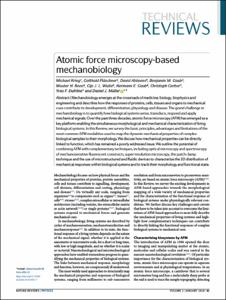Atomic force microscopy-based mechanobiology

Visualitza/Obre
Cita com:
hdl:2117/173416
Tipus de documentArticle
Data publicació2018-11-01
EditorNature
Condicions d'accésAccés obert
Llevat que s'hi indiqui el contrari, els
continguts d'aquesta obra estan subjectes a la llicència de Creative Commons
:
Reconeixement-NoComercial-SenseObraDerivada 3.0 Espanya
Abstract
Mechanobiology emerges at the crossroads of medicine, biology, biophysics and engineering and describes how the responses of proteins, cells, tissues and organs to mechanical cues contribute to development, differentiation, physiology and disease. The grand challenge in mechanobiology is to quantify how biological systems sense, transduce, respond and apply mechanical signals. Over the past three decades, atomic force microscopy (AFM) has emerged as a key platform enabling the simultaneous morphological and mechanical characterization of living biological systems. In this Review, we survey the basic principles, advantages and limitations of the most common AFM modalities used to map the dynamic mechanical properties of complex biological samples to their morphology. We discuss how mechanical properties can be directly linked to function, which has remained a poorly addressed issue. We outline the potential of combining AFM with complementary techniques, including optical microscopy and spectroscopy of mechanosensitive fluorescent constructs, super-resolution microscopy, the patch clamp technique and the use of microstructured and fluidic devices to characterize the 3D distribution of mechanical responses within biological systems and to track their morphology and functional state.
CitacióKrieg, M. [et al.]. Atomic force microscopy-based mechanobiology. "Nature Reviews Physics volume", 1 Novembre 2018, vol. 1, p. 41-57.
Versió de l'editorhttps://www.nature.com/articles/s42254-018-0001-7
Col·leccions
| Fitxers | Descripció | Mida | Format | Visualitza |
|---|---|---|---|---|
| s42254-018-0001-7.pdf | 4,014Mb | Visualitza/Obre |


